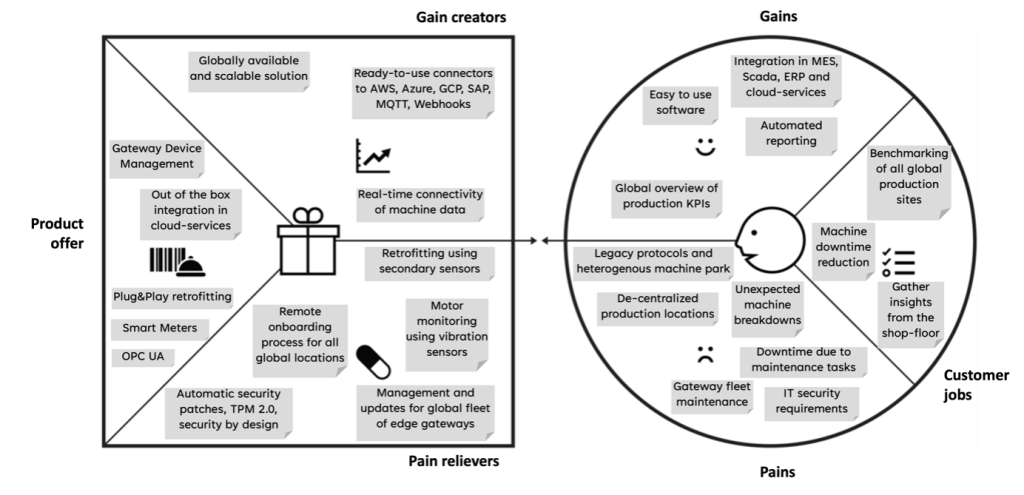Identify use-cases for IoT projects using the Value Proposition Canvas
Since the term “Industrie 4.0” was coined, Internet of Things (IoT) services and smart manufacturing efforts have evolved from conceptual lighthouse projects to widely-used services that deliver value to production planning, operations, and machine maintenance. One of the initial steps in an industrial IoT project is to prioritize the right use cases that promote confidence through seamless integration and tangible business benefits. To determine which efforts are value-creating and which are wasteful, I would like to introduce the Value Proposition Canvas method by Osterwalder (cf. Osterwalder et al. 2014).
The Value Proposition Canvas by Osterwalder

Customer profile
After empathizing with a certain customer group using the Design Thinking approach, a customer profile structures the assumptions of associated tasks, needs and delighters.
The “customer jobs” category shows the main tasks that customers try to achieve, such as functional jobs (e.g., completing tasks and solving problems), social jobs (e.g., gaining power or status), or emotional jobs (e.g., avoiding risk). The term section “pains” represents negative effects in a functional, social, or emotional manner. It refers to undesired product characteristics or certain fears of potential undesirable outcomes. On the other hand, the “gains” are divided into three categories. First, there are the required gains, which are mandatory for a solution to work. Then, there are the expected gains, which are what customers typically anticipate. Finally, there are the desired gains, which go beyond customer expectations and can even satisfy unexpected customer incentives.
From an internal perspective, the Value Map breaks down the main value propositions of a business model into a list of products and services. It assesses their ability to create gains and relieve pains for the customer.
The “Products offer” section represents a list of the company’s offerings and can be compared to a metaphorical shop window. The abilities of this offer to ease or eliminate negative outcomes are described as “pain relievers“. On the other hand, the “gain creators” focus on creating positive effects for the customer’s experience.
In general, when the gain creators enable customers to increase positive effects on their business and the pain relievers can decrease or even eliminate negative effects on the customer experience, a fit between the value proposition with the customer profile is achieved. This assumption suggests that the product offer aligns with the presumed requirements.
Application on CloudRail’s connectivity solution:
To illustrate how the method can be used, let’s apply it to the simplified value map of industrial manufacturers who are looking to digitize their operations. To implement this method in practice, the collection of customer jobs, gains, and pains is primarily done through interviews with relevant personas, workshops, or questionnaires.
Basic customer jobs could include: (1) KPI reporting across all global sites, (2) reducing machine downtime, and (3) gathering insights from the shop floor. Associated to these customer jobs are gains like an integration in MES, ERP and cloud-services or a global overview of production KPIs and pains like complex gateway fleet management, legacy protocols, de-centralized locations.
Once the customer profile is assessed, the value map evaluates how product offers can create customer satisfaction or relief customer dissatisfaction. Gain creators, such as ready-to-use connectors for cloud services like AWS and Azure provided by CloudRail, align with the gain of “Integration in MES, Scada, ERP, and cloud services.”
Pain relievers on the other hand resolve an issue or pain point of the customer. For example, a non-invasive retrofitting approach using secondary sensors can alleviate the challenges of working with legacy PLC protocols in a heterogeneous machine park. On the left-hand side of the canvas, the product offer represents products that include gain creators and pain relievers as inherent features. For CloudRail, this refers to a plug-and-play retrofitting solution with standardized gateway device management.
Rapid Validation of Assumptions is key
According to Osterwalder et al, great value propositions should focus on solving the pain points that matter most to customers, especially the most extreme ones. This will have the largest impact and provide the best business value to the customer. Additionally these extreme pain relievers are most of the times very easy to validate through direct feedback processes.
As highlighted in the blog post about the acceleration an IoT project, it is crucial to document key assumptions and validate them as early as possible. CloudRail’s ability to connect an industrial sensor in less than a minute significantly shortens validation cycles and prevents the persistence of false assumptions. When it comes to the introduced value proposition canvas, rapidly validating assumptions ensures that the value map aligns with the key needs of customers and users. Furthermore, the early stage implementation involves operators, production managers, and maintenance teams directly. This helps create a sense of being heard and involved in corporate-driven projects.
Limitations:
Some common mistakes when using the Value Proposition Design include mixing several customer segments into one profile, neglecting social and emotional jobs, and providing a vague description of the customer profile.
When planning an IoT initiative, the Value Proposition Design is introduced to map the value to the customer. However, the implementation still requires a complete business plan mapping, which can be done using tools like the Business Model Canvas by Osterwalder (Cf. Osterwalder et al. 2011).
Sources:
Osterwalder, Alexander; Pigneur, Yves (2011): Business model generation. A handbook for visionaries, game changers, and challengers. Hoboken, N.J.: Wiley.
Osterwalder, Alexander; Pigneur, Yves; Smith, Alan; Bernarda, Gregory (2014): Value Proposition Design. How to Create Products and Services Customers Want. 1st edition: John Wiley & Sons.
Ries, Eric (2011): The Lean Startup. 1st edition. New York: Random House USA Inc.
Strategyzer (2020): The Value Proposition Canvas. Available online at https://www.strategyzer.com/canvas/value-proposition-canvas, checked on 07/31/2023






